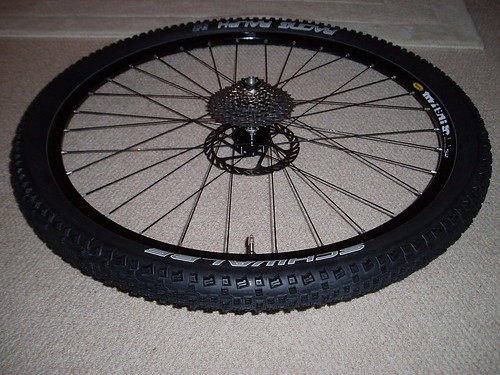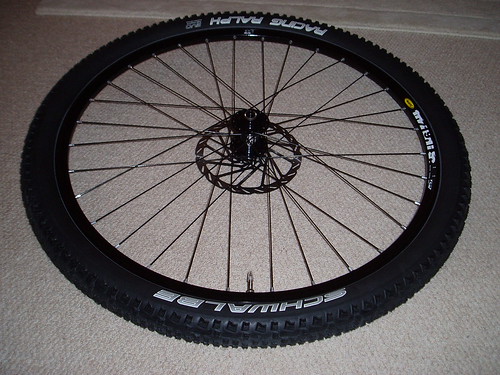- This topic has 12 replies, 9 voices, and was last updated 15 years ago by foxyrider.
-
wheel build tolerances
-
99percentchimpFree MemberPosted 15 years ago
Just curious to know others experiences – I’ve been finishing off some wheels for the first time (slowly to say teh least) – what sort of tolerances should i be aiming for… less than 1mm (approx.) on the rims and then when I get the tyres on I need to seat them carefully as there seems to be more radial trueness issues with the tyre/rim… an issue? Or no?
Your thoughts on this? Ta!RudeBoyFree MemberPosted 15 years agoI think that the ‘radial trueness, IE how well the wheel is true when looking at it from the side, is more important than the lateral, or side to side trueness. Does that make any sense?
It’s praps more crucial to get the hub absolutely dead central, in the wheel’s radial aspect. Otherwise, you’ll be going slightly ‘up and down’, as the wheels aren’t quite centered perfectly. You with me? And at high speeds, this can cause a very unsettling vibration.
Then, when that’s sussed, the lateral trueness can be tweaked. My rims are out a bit, actually, but it don’t seem to matter too much, as it’s only a couple of mm at most. I will have a look at it sometime soon. Obviously, this is more of an issue with rim brakes. Road bikes, with narrow high pressure tyres, suffer a lot more from imperfect wheels, as they don’t have so much rubber to compensate for slight imperfections in trueness.
So, get the radial trueness sorted first, then the lateral. It may take some time, to get it just so. Speshly if it’s yer first time. Under 1mm is ok, for mtb disc wheels, but you should be aiming for less than that, for roadie wheels. I’ve known wheel-builders to get wheels so true, a Rizla paper between rim and truing guide makes a difference!
Bearing in mind, newly built wheels may go slightly out of true after a couple of rides, as spokes bed in.
Spoke tension is important too, but this can be a bit complex,as different gauge spokes will have different tensions. I pluck spokes, to hear if they are all in ‘tune’. something like a DT Revolution spoke, with a narrow gauges, will give a higher pitch than a plain gauge spoke. But generally, when you grab a couple of spokes and squeeze them together, you don’t want more than about 5mm or so movement. Some builders like them really tight, but then they can start to become a bit ‘highly strung’, and more prone to snapping.
Well, I hope that’s helpful.
mboyFree MemberPosted 15 years agoshould i be aiming for… less than 1mm (approx.)
I should bloody hope so!
A good wheel should be no more than 0.2mm out radially, and 0.1mm out laterally. Of course this might be hard to acheive for the first build, but don’t despair as practice makes perfect… Just keep tweaking, you’ll get close enough soon enough.
RudeBoy makes several good points to which I will add that the biggest goal is getting all the spoke tensions pretty much identical to each other. A wheel that is true, but the spoke tensions are all over the place, will go out of true VERY quickly. Remember to keep *de-stressing* the wheel as you go about putting tension onto the spokes. This is a vital part of a wheel build that newbie builders often forget, then wonder why their newly built “true” wheel wobbles like jelly as soon as it has been ridden even just down the road!
*de-stressing is the process of relieving spoke wind up, which occurs when tensioning spokes in the wheel build process. Best way to do this is to grab the wheel by the rim, left hand at 9 o clock, right hand at 3 o clock, then hold it down to the floor, hub axle touching the floor. Then lean on it with all your weight! Move hands round the rim in 45 degree incrememnts and repeat. Once the one side is done, flip the wheel over and do the other side. Do this each time you think you’re getting close to the wheel being ready and true.
RudeBoyFree MemberPosted 15 years agoMboy comes and adds valuable input. Nice one.
I taught myself to build wheels. Surprisingly, my very first attempts weren’t too bad! And I actually enjoy doing it; sit down, couple of beers, some choons dem on- nice. Very therapeutic. There’s something very satisfying about having a set of wheels you’ve built up yourself.
Little by little. That’s the key to a good wheel, I find. Patience.
mboyFree MemberPosted 15 years agoMboy comes and adds valuable input. Nice one.
You sound so surprised, you sarcastic git 😉 hehehe
I taught myself to build wheels. Surprisingly, my very first attempts weren’t too bad! And I actually enjoy doing it; sit down, couple of beers, some choons dem on- nice. Very therapeutic. There’s something very satisfying about having a set of wheels you’ve built up yourself.
Totally. NEVER EVER begin to build a wheel when you have a time constraint! The best time and place is in the living room at home (clean up afterwards mind!), a beer (though not too many) on the go, listening to some music, or with the TV on in the background. Be methodical in your approach, but relax, take it easy, don’t stress and take your time! The results will be worth it.
Just don’t blame us when you’re building your 6th pair of wheels for the month, and can’t afford to keep your expensive new hobby up!
DibbsFree MemberPosted 15 years agoI use a clock gauge(DTI)when I build my wheels and aim to get them within +-5 or 10 thou (thousandths of an inch) in both directions.
Its probably over the top, but its not that difficult and I’ve never had the slightest problem with any of my wheels yet.99percentchimpFree MemberPosted 15 years agoCheers boys – Thanks for the feedback and input. I have got them pretty close now but obviously just need that little bit of extra time and input to get them as near to perfect as possible. I have been aiming for even spoke tension using tone and have managed to get the dish pretty good too.
Down to less than 1mm but I would like the radial trueness to be nearer to prefect than I have it at present – off with the tyres and out with the Rizla feeler gauges.
I’ve have found it very satisfying – beer and tunes and just stopping when it needs some more patience than I can muster.clubberFree MemberPosted 15 years agoIf I’m building wheels for mates (and when I did them at the bike shop I worked at), I’d always aim for truth/roundness under 0.5mm which is about as close as I can measure and is more than close enough.
For myself, tbh, so long as the spokes are running very similar tension and the wheel’s round, it doesn’t actually bother me too much and I wouldn’t get upset about 1mm side-to-side – tyres are generally at least 1mm out of round when fitted and if you’re running discs, slight side-to-side movement really doesn’t matter.
coffeekingFree MemberPosted 15 years agoIf building with second hand rims it is often nigh impossible to get a decent radial trueing, lateral is usually easy enough to within tiny amounts. Sub 0.5mm will be utterly un-noticable on all but the smoothest of slicks and roads unless you’re flying at very high speeds!
SinglespeedpunkFree MemberPosted 15 years agoIIRC the BS 6102 for bikes sets the tollerance for rim brake wheels at +/-2mm side-to-side and +/-4mm up-and-down. +/-4mm side-to-side on disc wheels 🙁
Even with out dial gauges you should be able to get below +/-0.5mm easily, make sure you have a white backdround behind the wheel and squint a bit 🙂
SSP
anotherdeadheroFree MemberPosted 15 years agoI use the very high tech equipment of a ruler, an elastic band and some insulation tape. Seems to work well enough.
99percentchimpFree MemberPosted 15 years agoCheers for the input on here…. Chuffed with this as first effort!
Put in a bit more time (following comments) and finally got them sorted.
Rear, Mavic rims on Hope Pro II, RRs, XTR cassette and Avid 160mm disc
and Front; Mavic rims on Hope Pro II, RRs and Avid 185mm disc
foxyriderFree MemberPosted 15 years agoI built mine about 4 weeks ago – Hope Pro II, DT Swiss Rev’s in black and DT Swiss 5.1D Rims – the first (rear) looked OK but after a day at Cwm carn was buckled laterally, trued it then went out again, and agin – the front (second wheel) was fine – I then read around and decided to do a rebuild – and hey presto a weekend at Afan was still true. I built mind to a tolerance of about .2-.3 mm. Cant you actually measure a tolerance of less then 0.2mm realistically and if so does it make a difference to the longevity of the wheel i.e. can get it true lat and radially but doesn’t tell you about the overall build quality does it?
The topic ‘wheel build tolerances’ is closed to new replies.

